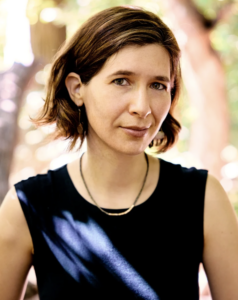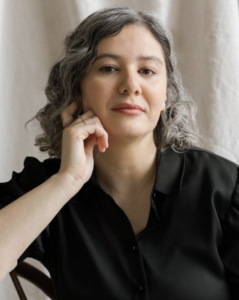Around the world, it’s common for fiction writers to moonlight as translators. Even in places where there’s a robust network of governmental support for writers, translation work provides, at least in theory, a welcome injection of income. Since it’s difficult to make a living writing novels or stories, collecting an extra source of funding is important. What better way to do that than by plying the same medium—language, storytelling—as you do in your art?
In Denmark, Pia Juul (The Murder of Halland; tr. Martin Aitken), Harald Voetmann (Sublunar, Awake; tr. Johanne Sorgenfri Ottesen), Olga Ravn (The Employees; tr. Martin Aitken), and Simon Fruelund, whose work I’ve translated, most recently The World and Varvara, have all translated books into Danish while also developing their craft as writers. Brazilian Paolo Henriques Britto (The Clean Shirt of It; tr. Idra Novey) and Argentine Federico Falco (A Perfect Cemetery, tr. Jenny Croft) have done the same. Jhumpa Lahiri was a prominent novelist and short story writer in English, of course, before she moved to Italy and began publishing in—and translating from—Italian. This is by no means an exhaustive list.
Unlike many of their counterparts elsewhere, most American novelists don’t translate books. Here in the United States, with its constellation of MFA programs, many teach creative writing. Those who don’t teach work full- or part-time jobs, sometimes more than one; unless you’re independently wealthy, it’s nearly impossible to make art and provide a decent life for yourself and your family. Like freelance writers, independent (non-academic) translators are part of the gig economy—a perilous balancing act between employment and under-employment. For translators whose primary income is derived from translation, it’s a constant hustle. Even if you’re signed to translate two books, say, you’re always thinking about landing a third, because you can’t let the well run dry. You want to know you’ve got a reliable income stream ahead of you. And with many translators increasingly losing jobs to generative AI, the hustle is even more acute today.
If you aspire to write fiction as well as translate it, as many translators do, then you have to steal time from some other part of your life. When I was translating my second book, Jussi Adler-Olsen’s The Absent One, I would wake up at 4 a.m. to work on my own novel for one hour before shifting, between 5 to 7 a.m., to the translation. Then I’d have breakfast with my wife and son and head out to my full-time job as the communications director for a nonprofit. Though I cherished the one hour I got to spend on my novel—a book that took 10 years to write and would ultimately find no publisher despite my then agent’s best efforts—it came at the cost of extreme exhaustion. It was a crushing schedule I could not maintain.
Though the novel I slowly pieced together in those wee morning hours was never published, nor were two of the manuscripts I wrote after that, the crucible of translation was a vitally important training ground that taught me how to read, and write, better—however much I lamented being pulled away from my own fiction and however many rejections I got. By immersing myself in novels at the most minute level, like a biologist studying spores in a Petri dish, I learned how to develop the backbone of stories, economize, and shape language. You might ask, isn’t that what all novelists do who regularly read and study fiction? To a degree, yes. But there’s a fundamental difference: reading fiction, even close reading, is not the same thing as recreating it via translation. Or, as Jenny Croft puts it, “Translation is the closest and most active form of reading.”
The crucible of translation was a vitally important training ground that taught me how to read, and write, better.
We’ve recently witnessed a flowering of new fiction by translators. In March of this year, Bloomsbury published The Extinction of Irena Rey by Croft, whose first book, Homesick, was originally written in Spanish as a novel but later published as a memoir in English. Last year, Penguin Random House published Take What You Need, the third novel by Idra Novey following Those Who Knew and Ways to Disappear. In July, HarperCollins will publish Korean translator Anton Hur’s debut novel Toward Eternity, while recent National Book Award for Translation winner Bruna Dantas Lobato’s Blue Light Hours, also her debut, will be published by Grove Atlantic in October. That same month, SFWP will publish my own debut novel, The Book of Losman. This, too, is no exhaustive list.
It’s hardly surprising that translators write fiction. The question is: How does each writer’s background as a translator impact their work as fiction writers? I asked Croft, Novey, and Dantas Lobato this question.
“I think the most important thing my translation work has done for my fiction has been to de-center standardized U.S. storytelling, which is difficult to do because U.S. storytelling is typically held so firmly in place by marketing, MFA programs, etc.,” Croft says. Croft, widely known as the translator of Nobel laureate Olga Tokarczuk’s Flights and The Books of Jacob and for her prominent role in the #namethetranslator movement, translates from Argentinian Spanish, Polish, and Ukrainian. She won the 2018 International Booker Prize for her work on Flights and teaches at the University of Tulsa. “My translation work makes me hyper-aware of the linguistic structures a writer might otherwise take for granted, such as syntax and etymologies,” she added. “My years as a translator have taught me to judge all works on their own terms. And as a writer, to try and understand the terms of the work I’m embarking on.”
 This de-centering is clearly visible in The Extinction of Irena Rey, which Croft uses as a metafictional vehicle to explore, among other things, the act of translation as a creative endeavor. In it, a Spanish-speaking translator joins seven other translators at the home of a famous Polish novelist, the eponymous Irena Rey, to simultaneously translate Rey’s masterpiece into eight different languages. It is a novel—Decameron-like in its framing—that very deliberately, and playfully, employs elements linked to Croft’s work as a translator. Though this novel involves translation, she points out, her next will not. This is an obvious but important distinction to make: translators don’t have to write about translation.
This de-centering is clearly visible in The Extinction of Irena Rey, which Croft uses as a metafictional vehicle to explore, among other things, the act of translation as a creative endeavor. In it, a Spanish-speaking translator joins seven other translators at the home of a famous Polish novelist, the eponymous Irena Rey, to simultaneously translate Rey’s masterpiece into eight different languages. It is a novel—Decameron-like in its framing—that very deliberately, and playfully, employs elements linked to Croft’s work as a translator. Though this novel involves translation, she points out, her next will not. This is an obvious but important distinction to make: translators don’t have to write about translation.

Like most translators, including the ones here, Idra Novey had literary aspirations from an early age. “I started writing poems and stories in elementary school and have never stopped,” she says. “Writing is my way of processing the world, and translation has become integral to my writing process. I was drawn to translate writers I admired and whose work I wanted to share with others, who couldn’t read it in the original.”
For Novey, who teaches at Princeton and who as a translator is perhaps best known for her work on Clarice Lispector’s The Passion According to G.H, “the questions that guide my word choices when recreating the sensibility of another writer in English have become integral to the questions that guide my word choices for each character in [a] novel.”
She doesn’t shy away from incorporating questions of translation in her fiction. Her first novel, Ways to Disappear, is about an American translator who flies to Brazil to search for a famous novelist who has gone missing. Much like The Extinction of Irena Rey, Ways to Disappear reads like a novel conceived and developed outside the confines of an MFA workshop. Novey’s experience as a translator enriches her narratives at the most fundamental level of storytelling: language.
 “I think about how to convey the sensibility of a speaker through the syntax, how the character’s idiosyncrasies will manifest in the cadence and length of the sentences,” she says. “In Take What You Need, one protagonist speaks Spanish in the car with her family and I wrote their lines in Spanish first, then translated them into English. I did that for many scenes in Ways to Disappear as well, as almost the entirety of that novel takes place while the translator from the U.S. is in Brazil and I wanted the innuendos in the dialogue, and the humor, to evoke a sense of characters speaking to each other in Portuguese.”
“I think about how to convey the sensibility of a speaker through the syntax, how the character’s idiosyncrasies will manifest in the cadence and length of the sentences,” she says. “In Take What You Need, one protagonist speaks Spanish in the car with her family and I wrote their lines in Spanish first, then translated them into English. I did that for many scenes in Ways to Disappear as well, as almost the entirety of that novel takes place while the translator from the U.S. is in Brazil and I wanted the innuendos in the dialogue, and the humor, to evoke a sense of characters speaking to each other in Portuguese.”
This kind of creativity, deeply embedded in culture and language, is paramount to the work of a translator. For translators who also write fiction, it offers another layer of possibility not available to writers who think and write solely in English. The best instruction for any writer—besides reading deeply and widely—is to become immersed, at the granular level, in another language.

Bruna Dantas Lobato, originally from Brazil, is perhaps best known for her translation of Sténio Gardel’s The Words That Remain, which won the 2023 National Book Award for Translated Literature. She has a slew of forthcoming translations in the pipeline, and will begin teaching at Grinnell College in the fall. Her debut novel, Blue Light Hours, follows the lives of two women who live 4,000 miles apart—one (a mother) in Brazil and one (her daughter) in Vermont, where she’s a student.
 Though it’s a relatively slim book, Blue Light Hours took her 10 years to write—and she started writing it, in English, before she began to translate. Ever since she moved to the United States as a student, she says, she has been drawn to writing in English. “It was like tapping into my subconscious, a dreamland,” she says. “Fiction happens to me in English, not Portuguese.”
Though it’s a relatively slim book, Blue Light Hours took her 10 years to write—and she started writing it, in English, before she began to translate. Ever since she moved to the United States as a student, she says, she has been drawn to writing in English. “It was like tapping into my subconscious, a dreamland,” she says. “Fiction happens to me in English, not Portuguese.”
What brought Dantas Lobato to translation was a keen desire to return to her roots; she missed her native language. “My life was fragmented,” she recalls. “There was this one person I was before, and there was this one person I was. There was cognitive dissonance, and I wanted to bridge the gap. I brought a lot of what I knew about writing to my work as a translator.”
The main thing translation has given her, she says, is “an expansive writer’s toolkit.” When she began putting stories to paper, she felt limited as a writer. As a translator, however, she was working with different voices and styles—from third person to first person—and this experience opened up new vistas in her fiction and boosted her confidence: “Because I’ve translated all these books, I don’t feel intimidated at all. I got my chance to try out different things. And I feel I can embody any voice I want.”

 My own debut, The Book of Losman, is set in Copenhagen. Like Irena Rey and Ways to Disappear, questions of translation play a key role in the novel. The protagonist, Losman, is a literary translator with Tourette Syndrome who becomes involved in an experimental drug trial that allows him to relive childhood memories in a dubious attempt to find the cause of his condition. It incorporates elements pulled directly from my experience as an expat in Denmark and as a translator—the latter quite literally. The opening scene, for example, is a re-imagining of Simon Fruelund’s short story “Kramer” from his collection Milk & Other Stories, which I translated. I insert Losman directly in the story, and that allows him to interact with the characters Fruelund created. And there are other deliberate echoes from each of Simon’s books reverberating throughout the novel. Part of this is thematic, but another part is something deeper: When you spend months, even years, translating a writer’s books, you become immersed in that world and you want to explore it further. Although the book was written in English, I imagined my characters speaking Danish and that impacted the cadence of their voices. Like Dantas Lobato, who views her work—translation and fiction alike—as in dialogue with one another, The World and Varvara and The Book of Losman are thematically entwined. Over the years, my translation work often diverted attention from my writing, and that used to bother me. But I couldn’t have written The Book of Losman had I not first delved deeply, minutely, into Danish fiction and culture. The two elements are imprinted in the book’s pages like a colophon. Being able to translate is a privilege; it’s also an education that has made me a stronger writer. This, I am certain, is true for any writer-translator with a desire to tell stories.
My own debut, The Book of Losman, is set in Copenhagen. Like Irena Rey and Ways to Disappear, questions of translation play a key role in the novel. The protagonist, Losman, is a literary translator with Tourette Syndrome who becomes involved in an experimental drug trial that allows him to relive childhood memories in a dubious attempt to find the cause of his condition. It incorporates elements pulled directly from my experience as an expat in Denmark and as a translator—the latter quite literally. The opening scene, for example, is a re-imagining of Simon Fruelund’s short story “Kramer” from his collection Milk & Other Stories, which I translated. I insert Losman directly in the story, and that allows him to interact with the characters Fruelund created. And there are other deliberate echoes from each of Simon’s books reverberating throughout the novel. Part of this is thematic, but another part is something deeper: When you spend months, even years, translating a writer’s books, you become immersed in that world and you want to explore it further. Although the book was written in English, I imagined my characters speaking Danish and that impacted the cadence of their voices. Like Dantas Lobato, who views her work—translation and fiction alike—as in dialogue with one another, The World and Varvara and The Book of Losman are thematically entwined. Over the years, my translation work often diverted attention from my writing, and that used to bother me. But I couldn’t have written The Book of Losman had I not first delved deeply, minutely, into Danish fiction and culture. The two elements are imprinted in the book’s pages like a colophon. Being able to translate is a privilege; it’s also an education that has made me a stronger writer. This, I am certain, is true for any writer-translator with a desire to tell stories.
The post Want to Write Better Fiction? Become a Translator appeared first on The Millions.













